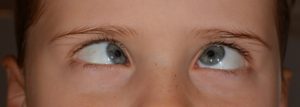 So, you’ve gotten your visual acuity score and are feeling pretty good about your exam. Now it’s time to get physical! Your depth perception, color vision, eye muscle movements (left, right, up, down), peripheral vision and how your eyes react to light will be tested. Take a deep breath, we’re about to begin!
So, you’ve gotten your visual acuity score and are feeling pretty good about your exam. Now it’s time to get physical! Your depth perception, color vision, eye muscle movements (left, right, up, down), peripheral vision and how your eyes react to light will be tested. Take a deep breath, we’re about to begin!
How Curvy Are You?
There’s a test called keratometry that measures the curvature of the clear surface of the eye called the cornea. This is performed by focusing a circle of light on the cornea and measuring its reflection. This is a critical test for someone who wants to wear contacts as it determines the proper size.
Less than 20/20? Time to Don the Mask
You doctor will equip you with a special mask called a phoropter which is used when you need glasses or contacts. It measures apparatus determines the strength you need to compensate for your eye’s weakness (e.g., nearsightedness, farsightedness or astigmatism). The mask’s eye holes are equipped with a variety of lenses that are used to find the best lens for you. The optometrist use a retinoscope (looks like a flashlight) to see how the lens focuses light. The doctor may also use an instrument that evaluates the focusing power of each eye as well. Then you get to contribute your feedback by choosing between the lenses in the quest to give you the clearest vision possible.
Left, Right, Up, Down
Although we don’t think about it, but our eyes work really hard for us all day. To see a clear image our eyes continuously change focus, move and work together. They are constantly in motion as they uncover the world before us. Your optometrist will ask you to move your eyes in various directions and check for physical anomalies that may prevent your eyes from moving or focusing effectively.
Time for Your Evaluation
After your doctor has performed the tests that he deems necessary for you he will evaluate your results and give you a diagnosis. You’ll discuss any health or eye problems that have been discovered and explain treatment options. In some cases, you may even be referred to another optometrist or health care professional for consultation and treatment.
All done!
Now that wasn’t so bad, was it?
Having your annual eye exam helps to protect your eye’s health as well as being an early warning for diseases such as diabetes, high cholesterol, hypertension, thyroid disease, cancer, tumors and even autoimmune disorders! For your overall well-being make your eye exam a MUST not a maybe.
We welcome new patients and it’s easy to get started. You can fill out our online New Patient form and we’ll be happy to pencil you in. Or give us a call to set your appointment today.
Resources
Comprehensive Eye and Vision Examination
http://www.aoa.org/patients-and-public/caring-for-your-vision/comprehensive-eye-and-vision-examination?sso=y

